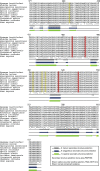Filovirus receptor NPC1 contributes to species-specific patterns of ebolavirus susceptibility in bats
- PMID: 26698106
- PMCID: PMC4709267
- DOI: 10.7554/eLife.11785
Filovirus receptor NPC1 contributes to species-specific patterns of ebolavirus susceptibility in bats
Abstract
Biological factors that influence the host range and spillover of Ebola virus (EBOV) and other filoviruses remain enigmatic. While filoviruses infect diverse mammalian cell lines, we report that cells from African straw-colored fruit bats (Eidolon helvum) are refractory to EBOV infection. This could be explained by a single amino acid change in the filovirus receptor, NPC1, which greatly reduces the affinity of EBOV-NPC1 interaction. We found signatures of positive selection in bat NPC1 concentrated at the virus-receptor interface, with the strongest signal at the same residue that controls EBOV infection in Eidolon helvum cells. Our work identifies NPC1 as a genetic determinant of filovirus susceptibility in bats, and suggests that some NPC1 variations reflect host adaptations to reduce filovirus replication and virulence. A single viral mutation afforded escape from receptor control, revealing a pathway for compensatory viral evolution and a potential avenue for expansion of filovirus host range in nature.
Keywords: Ebola virus; Filovirus; NPC1; Niemann-Pick C1; Positive selection; Virus-host co-evolution; bats; evolutionary biology; genomics; host range; infectious disease; microbiology; viral receptor; viruses.
Conflict of interest statement
The authors declare that no competing interests exist.
Figures














References
-
- Amman BR, Carroll SA, Reed ZD, Sealy TK, Balinandi S, Swanepoel R, Kemp A, Erickson BR, Comer JA, Campbell S, Cannon DL, Khristova ML, Atimnedi P, Paddock CD, Crockett RJ, Flietstra TD, Warfield KL, Unfer R, Katongole-Mbidde E, Downing R, Tappero JW, Zaki SR, Rollin PE, Ksiazek TG, Nichol ST, Towner JS. Seasonal pulses of marburg virus circulation in juvenile Rousettus aegyptiacus bats coincide with periods of increased risk of human infection. PLoS Pathogens. 2012;8:e11785. doi: 10.1371/journal.ppat.1002877. - DOI - PMC - PubMed
-
- Amman BR, Jones ME, Sealy TK, Uebelhoer LS, Schuh AJ, Bird BH, Coleman-McCray JD, Martin BE, Nichol ST, Towner JS. Oral shedding of Marburg virus in experimentally infected Egyptian fruit bats (Rousettus aegyptiacus) Journal of Wildlife Diseases. 2015;51:113–124. doi: 10.7589/2014-08-198. - DOI - PMC - PubMed
Publication types
MeSH terms
Substances
Grants and funding
LinkOut - more resources
Full Text Sources
Other Literature Sources
Research Materials

